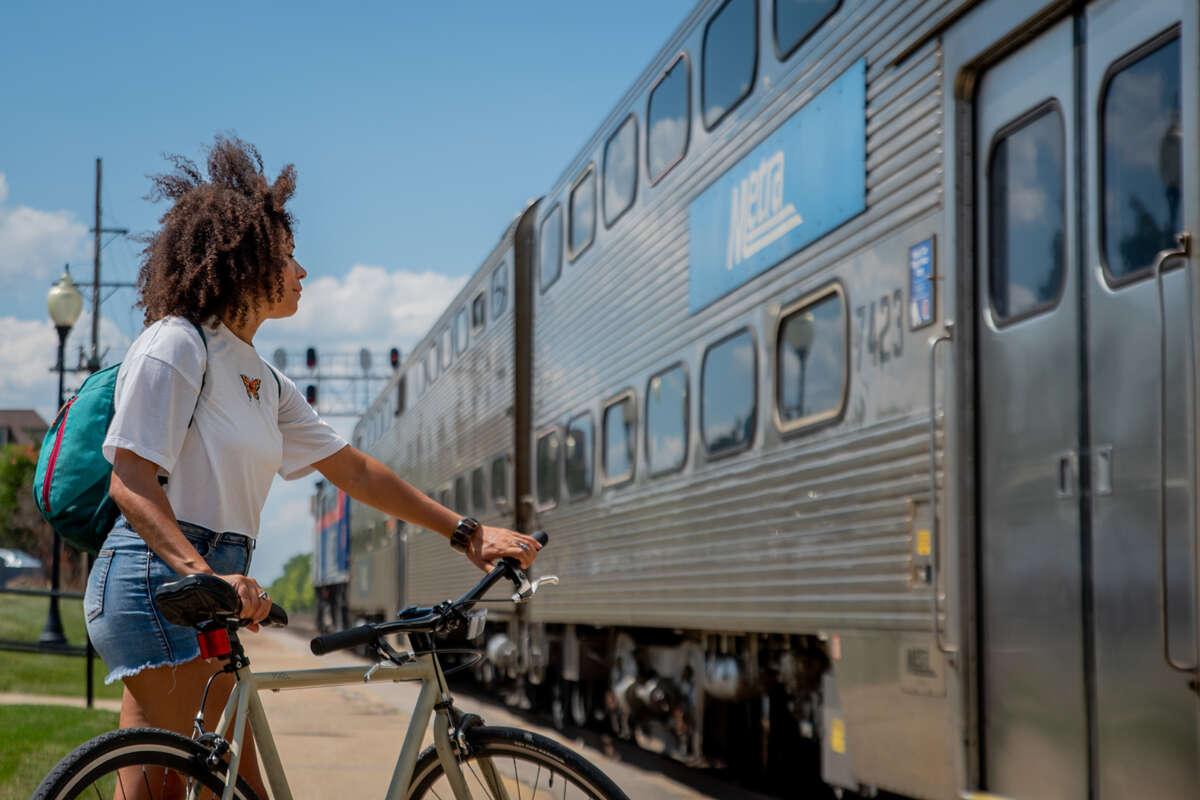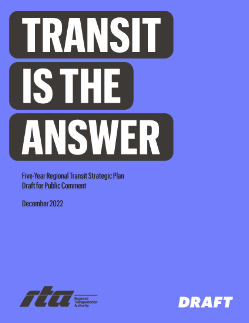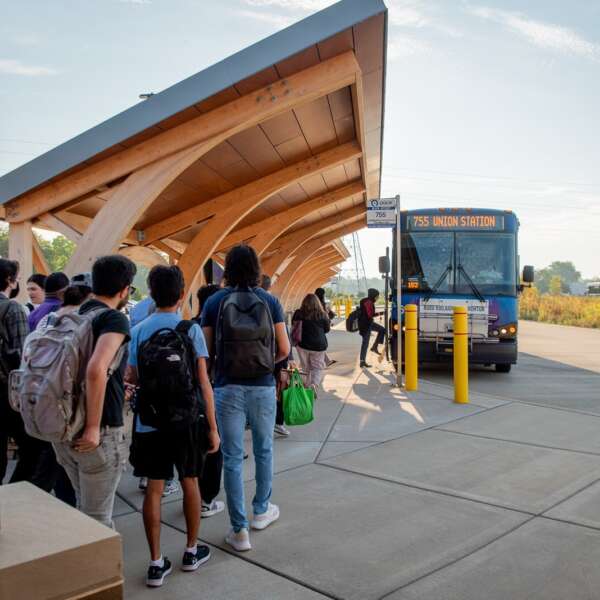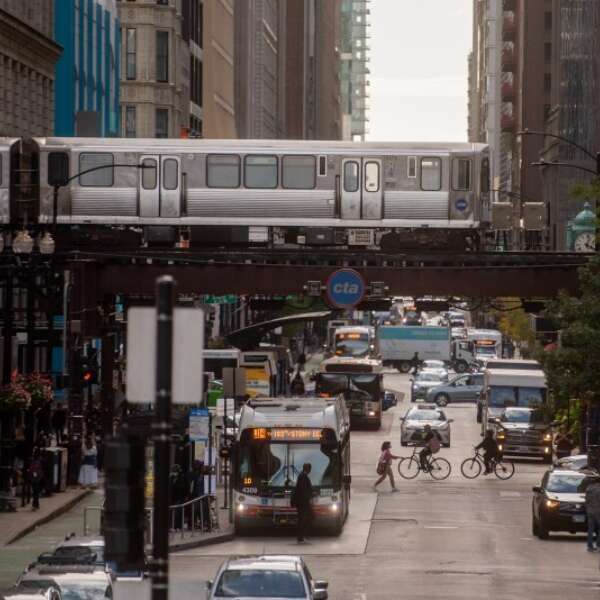How can we address the most urgent challenges facing our region? Transit is the Answer.
December 5, 2022
December 5, 2022


Today, the RTA released a draft of Transit is the Answer, the 2023 regional transit strategic plan that has been in development for more than a year. The plan vision is safe, reliable, accessible public transportation that connects people to opportunity, advances equity and combats climate change. The plan outlines 14 key Areas of Advocacy and Action that were co-created with stakeholders to guide priorities in areas like funding, safety, speed and reliability. In addition, it identifies a number of actions that the RTA, Chicago Transit Authority (CTA), Metra and Pace will work together on in 2023 including:
“We see transit as the answer to the economic viability of our region and to addressing many of the most urgent challenges facing us today,” said RTA Board Chairman Kirk Dillard. “Transit is the answer to concerns around equity, economic prosperity and climate mitigation and investing in transit is an investment in solutions for our region’s future.”
The draft is open for public comment through January 9, and the RTA Board of Directors will vote on adoption during their February 16 meeting. The RTA hosted a virtual public hearing from 4:00-6:00 p.m. on December 7, inviting people to weigh in on both Transit is the Answer and the proposed regional transit budget. The strategic plan presentation from the public hearing may be viewed on YouTube. Those interested in joining the coalition to advance the plan can sign up for communications and future calls to action.
“The RTA releases a strategic plan every five years, but never before has the need been so significant and the opportunity so great,” said RTA Executive Director Leanne Redden. “Almost overnight, the COVID-19 pandemic changed public transportation systems across the nation, and we are all working on solutions that rise to the occasion. With ridership still not reaching pre-pandemic levels and federal relief dollars projected to run out at the end of 2025, we knew we needed to build a coalition to create a plan that addresses the needs of riders and maps out new ways to fund our unique system.”
Getting ahead of a future $730 million annual budget gap
One of the most important aspects of the plan is pursuing additional funding for transit operations, which is set to hit a cliff in 2026 that can’t be solved by raising fares or cutting service. At the end of 2021, the RTA completed allocation of $3.4 billion in federal relief funding provided to the region to help offset fare revenue losses from declining ridership due to the pandemic. Remaining federal relief funding is being used to balance the current budget but is projected to last through the third quarter of 2025.
As part of the development of the strategic plan, financial and planning experts from the RTA, CTA, Metra, Pace and Chicago Metropolitan Agency for Planning (CMAP) worked together as part of a 10-Year Financial Plan technical group to analyze different financial scenarios. The group estimated that beginning in 2026, the system could face an annual budget gap of $730 million assuming current service levels are maintained regionwide. The group then evaluated 27 revenue options and identified 11 that have the potential to address gaps. Their findings show that there is no simple or singular funding solution; instead, the RTA will engage its partners and stakeholders to pursue a combination of available solutions to close the funding gap and ensure that a sound public transportation system is available in the future.
Making transit safer for all riders
Safety on transit is a top priority and one of the concerns the RTA heard from riders and stakeholders most frequently throughout the planning process. Safety and security are issues that transit agencies the world over are grappling with, and Transit is the Answer commits the RTA to work together with CTA, Metra and Pace to convene a cross-sector and cross-regional safety and security summit to explore holistic solutions to these challenges affecting public transportation.
The RTA will also continue its work with communities to help build more transit-friendly neighborhoods so that transit access is safer and easier. This will include promoting equitable transit-oriented development, creating plans to construct mobility hubs, and curb management plans that promote walking and biking to transit stations and stops.
Improving the rider experience
The RTA heard improvements to the rider experience and regular communication about disruptions should be a priority. Transit is the Answer calls for a variety of actions that address this concern, including commissioning an independent review of the accessibility and quality of rider communication, signage, and information-sharing across and between agencies.
Another step is to partner with roadway agencies to build more transit-friendly streets and advance bus rapid transit. The RTA will fund and support corridor planning projects and advocate for the Illinois Department of Transportation (IDOT) and local government agencies to champion bus projects and to secure more space dedicated to transit on regional roads.
Prioritizing accessibility, equity, climate change in capital investment
Improving accessibility is another area of focus in Transit is the Answer. The RTA will lead the development of a regional accessibility improvement plan with the CTA, Metra and Pace. This plan will provide a comprehensive catalog of capital projects that prioritizes investment and identifies funding sources to achieve full system accessibility within and across the three transit systems.
Accessibility — specifically the degree to which a project improves accessibility for people with disabilities — will also be one of 12 new measures used to evaluate all projects added to the regional capital program each year. Other measures will include access that the projects provide to key destinations, the distribution of project benefits to location(s) identified under the U.S. Department of Transportation’s Justice 40 program (an initiative that addresses decades of underinvestment by allocating at least 40 percent of the benefits from federal investments to disadvantaged communities), and the project impact to climate benefits. These metrics will help the RTA, CTA, Metra and Pace understand and communicate the impact of regional capital investments as the agencies work together to spend current capital funding wisely and pursue additional capital funding to address the long-standing capital maintenance backlog.
“Transit is the Answer addresses current challenges with detailed action items and sets a roadmap for the future of the region’s transit system,” said RTA Director, Planning and Market Development, Jessica Hector-Hsu. “At a time when transit operators and planning agencies across the country are trying to adjust to new norms brought about by the COVID-19 pandemic, the RTA is proud to lead the system into the future with a plan co-created by a diverse group of stakeholders. Nothing in the plan can be accomplished alone; we look forward to collaborating with our partners to realize this vision.”
Making the plan
Engagement with a wide spectrum of audiences was a key component of development of Transit is the Answer. The RTA considered voices that are too often left out of the planning process and engaged in ways the agency never had before to co-create a strategy that the region can get behind for the future of transit.
Since August 2021, the RTA has published guest blogs from regional and national transit thinkers, invited guest speakers to board meetings, met with elected officials and community groups, received thousands of responses to surveys, convened stakeholder working groups with more than 100 people from more than 70 organizations, engaged riders at community events across six counties and engaged with more than 20,000 followers on social media. This has resulted in a plan that prioritizes riders and their experiences using transit.
“I’m a CTA bus explorer; I like getting on a bus every once in a while, and riding it from one end of the line to the next just so I can see what I’ve missed over the years, and this is very valuable to me,” said Rochelle Jackson, who led the charge that reinstated the CTA 157 Ogden bus in North Lawndale in 2020 and was recruited to one of the RTA’s three stakeholder working groups that helped to co-create the plan. “It’s very important to keep our transit system going and get the ridership back up. Transit is very valuable to the city and the suburbs because people have to go to work, they have to go to school, they play, and a lot of people can’t afford to buy a car or call an Uber or taxi every single day. Transit has to remain a valuable asset for the region.”
Subscribe to our Newsletter
Related Articles
 For the third year in a row, regional transit ridership was up by double-digits in 2024
For the third year in a row, regional transit ridership was up by double-digits in 2024
Ridership across the Chicago region’s transit system continued to increase throughout 2024, according to the latest data from CTA, Metra, and Pace. The regio...
January 28, 2025 RTA is seeking $1.5 billion in annual operating funding. What would that mean for your commute?
RTA is seeking $1.5 billion in annual operating funding. What would that mean for your commute?
On January 15, RTA released Transforming Transit, a vision for the regional transit system with $1.5 billion in annual operating funding supported by a stron...
January 28, 2025 RTA proposes reforms to increase efficiency, transparency, and accountability across transit system
RTA proposes reforms to increase efficiency, transparency, and accountability across transit system
RTA is proposing a historic restructuring of the region’s transit governance to maximize the impact of new operating funding and ensure all riders experience...
January 24, 2025 What Chicago can learn from Philadelphia as the transit fiscal cliff approaches
What Chicago can learn from Philadelphia as the transit fiscal cliff approaches
Beginning in 2026, Chicago’s regional transit system faces a projected $770 million annual budget gap. At nearly 20% of the annual operating budget, this gap...
January 23, 2025 2024 recap: RTA brings 8 Transit Station Activations throughout region as part of pilot program
2024 recap: RTA brings 8 Transit Station Activations throughout region as part of pilot program
In spring 2024, RTA announced more than $120,000 in funding for eight Transit Station Activation projects as part of a pilot program with the goal of improvi...
January 9, 2025 Village of La Grange adopts comprehensive plan calling for more density near transit
Village of La Grange adopts comprehensive plan calling for more density near transit
In November, the Village of La Grange voted to adopt La Grange Forward, a comprehensive plan developed as part of the RTA’s Community Planning program. The d...
January 7, 2025